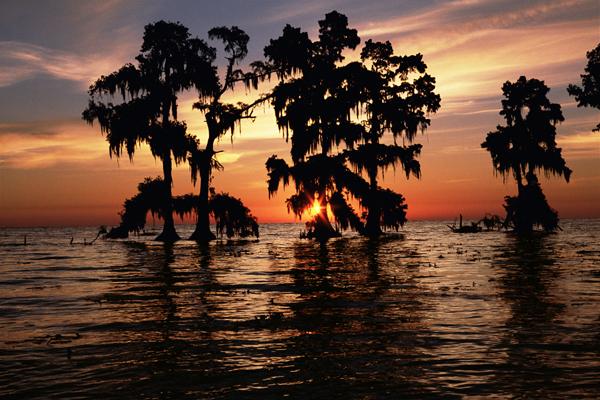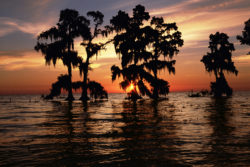Julia Sims
Julia Sims is a nature photographer best known for her work in Manchac Swamp between Baton Rouge and New Orleans.

Courtesy of Julia Sims.
This color reproduction is of Julia Sims' photograph “Cypress Sunbeam.” Sims uses no filters other than warming or polarizing filters, and credits nature with presenting her with the just the right image.
Julia Brumfield Sims ranks among Louisiana’s foremost nature photographers for her remarkable images of the wildlife, landscape, and waterways of the state’s coastal marshes and her photo-documentation of the Manchac Swamp. Her work has appeared in several books and national publications, including National Geographic, Audubon, Sierra, Ducks Unlimited, Birders World, Natural History, and SINRA, a Japanese nature magazine.
Sims was born on February 17, 1942, in Baton Rouge. She currently resides in Ponchatoula. She was not initially drawn to the outdoors for the purpose of recording Louisiana’s natural landscape. She and her husband, Joe Arthur, simply enjoyed being enveloped by the visual purity of the environment and its natural sounds. Photography came later. Sims’ interest in the natural environment began while her husband was in the Army and stationed in Germany. “We took up hiking in the mountains and that opened up a whole new world to me,” she once said in an interview for her book Manchac Swamp: Louisiana’s Undiscovered Wilderness. “When we got back to Louisiana, we couldn’t do that. So we took up canoeing. I enjoyed that, but it didn’t give us the same feeling as being up in the mountains.” Then a friend, John Dahmer, took them deep into the Manchac Swamp in his airboat. “When we went back there in his airboat and stopped, it was the feeling that I had back in the forests of Germany. That same feeling swept over me. That’s when I knew that I was going to stay back there … I had lived in Louisiana all my life and I had never been that far back in a swamp.” The next day, the Sims bought her own airboat.
Being a simple spectator to that beauty was not enough. Through photography, she could become a participant in the natural drama. After taking a beginner’s “this is your camera” course at Newcomb College in New Orleans, she signed up for wildlife photography workshops around the country taught by some of the best shooters in the business. Her work gradually improved, so much so that by the mid-1980s she had a contract with the Peter Arnold Agency in New York, one of the most prestigious stock photo houses in the nation.
Sims’ fascination with Louisiana’s wetlands began as a child growing up in Baton Rouge. During frequent family automobile trips from Baton Rouge to New Orleans along Airline Highway, she loved to let her imagination wander into the seemingly impenetrable dark swamps that came up to the highway’s edge. These were the days before interstate highways and air-conditioned cars. A cooling breeze meant opening the window. “I remember hanging out the car window as we drove and seeing the southern edge of the beautiful Manchac Swamp. I can remember thinking, ‘What’s back there?’ There was just that wall. To think, now I’m back there. Maybe even then there was something there that drew me. One of my favorite stories as a child was The Secret Garden. It’s a story of a little girl finds this magical garden. I’d look at the swamp and think there was a magical garden back there.” (Frances Hodgson Burnett’s 1912 novel The Secret Garden is about a lonely English girl who found solace and wonders of life on a Yorkshire moor that awakened her imagination.)
Sims had an ordinary childhood growing up in Baton Rouge. She attended Baton Rouge High and, like many teenagers in the late 1950s, had few special interests other than weekend dates. After graduation in 1960, she settled in at Louisiana State University where she initially had hoped to become a veterinarian, but “people said girls didn’t do that, but I love animals.” Instead, like many young women of the time, she went on to get a degree in education. After graduation in 1964, she struck out on her own, moved to the New Orleans French Quarter and took a teaching job, first at a fashionable Episcopal school in the city’s Uptown neighborhood, and then later in a public school across the river from the city.
Gradually, photography and nature became major forces in her life, a life filled with tragedy. The beauty and artistic expression that the Louisiana swamp provided Sims, and the journey into that other world, have helped her deal with tragic times, such as her mother’s death from cancer in 1967; the brutal murder of her father, Henry Alva Brumfield, in 1973; and the sudden death of her younger brother Billy in 1989. “The silence and solitude out there have been real healing,” she once said. “It’s a peace I feel out there, a peace I can’t explain. I think that’s why it never gets old. Even when I don’t take a picture, it’s been healing. It gives you a lot of time to think. I’ve shed many tears out there.” In 1996, Governor Mike Foster appointed Sims to the state pardon board, a position she held until 2008.
After such personal adversity, outdoor photography became increasingly important to Sims. “It took me awhile to realize what I had missed, because it was all mixed in with grief. Then it spilled over into healing that had to be done.”
Over the past twenty years, Sims has taken thousands of magnificent photographs of Manchac Swamp, many of which appeared in the book Manchac Swamp: Louisiana’s Undiscovered Wilderness, published in 1996 by LSU Press.
“It’s not the photography I love, it’s being outside that I love,” she said in an interview for the book, Solace of Nature. “I can’t go out there and not do anything. I enjoy photography and it’s a challenge to capture a moment and then later see what you captured. I don’t use filters, other than polarizing and warming filters, and I don’t enhance the photograph. When I get just the right moment, I say Mother Nature did it, but I was there to capture the opportunity. You have to be ready for it happens when you least expect it. Sometimes, though, I come back and my husband asks me if I got any good pictures and I say no. He asks why I’m so happy. I say, ‘Because I was there.’ ”
Sims’s photographs are part of the permanent collections of the Louisiana Art and Science Museum in Baton Rouge, North Oaks Hospital in Hammond, The Louisiana Land and Exploration Office in New Orleans, and Tulane University’s law school and medical school in New Orleans. In 1998, she received the President’s Award and First Place Photography Award from the Press Club of New Orleans for her photo story on Manchac Swamp, which appeared in Louisiana Cultural Vistas magazine. She has also received the Best of Show award at the Three Rivers Art Festival in Covington.
